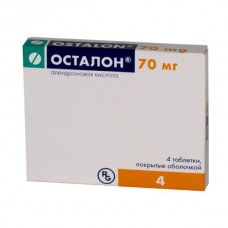Expiration date: 01/2026
The composition and form of issue:
Tablets, film-coated. 1 tablet contains:
of alendronate sodium trihydrate 91,35 mg
(corresponds to 70 mg Alendronic acid)
excipients:
core: microcrystalline cellulose silica colloidal anhydrous croscarmellose sodium magnesium stearate
shell: Chandelier Clear LC103 (MCC, carrageenan, macrogol 8000)
in blistere 4 PCs the paper cartons of 1 blister.
Description pharmaceutical form:
White, round, biconvex coated tablets, engraved "M14" on one side.
Pharmacokinetics:
Absorption after a single dose of 35 or 70 mg in the morning on an empty stomach, 2 hours before Breakfast, is 0.64%. With a shortened interval between administration of drug and food of 0.46 to 0.39%. This reduction of absorbability has no significant effect on the drug's effectiveness. Simultaneous reception of coffee or orange juice reduces bioavailability by 60%.
Distribution: after ingestion temporarily distributed in soft tissues, then integrates into the bone tissue. Binding to plasma proteins is 78%.
Metabolism: evidence that the metabolism of alendronate in humans, no.
Excretion: absorbed, but not ustroivshis in the bone alendronate is rapidly excreted by the kidneys. Maximum saturating capacity of bone tissue in animals failed to install the on/in the introduction of a cumulative daily dose, equal to 35 mg/kg. Despite the lack of evidence for kidney disease likely decrease excretion of alendronate with increased accumulation in the bone tissue.
Description pharmacological action:
Alendronate sodium is bisphosphonate, a synthetic analogue of pyrophosphate that bind to the hydroxyapatite of bone tissue. Being non-hormonal specific inhibitor of the activity of osteoclasts, prevents bone resorption. Does not affect the process of bone formation. Stimulates bone formation, restores a positive balance between resorption and bone reconstruction. Progressive increases bone mineral density (regulates calcium and phosphorus metabolism), promotes formation of bone tissue of normal composition and structure.
Indications:
- treatment of osteoporosis in postmenopausal women (reducing the risk of vertebral fractures and the head of the hip bone)
- treatment of osteoporosis in men (lower risk of developing fractures of the vertebrae and hip bones).
Contraindications:
- hypersensitivity to any component of the drug
- anomalies of the esophagus and other factors that hinder the patency of the esophagus (achalasia, stricture, etc.)
- the inability of the patient to stay upright, even sitting, within 30 min.
- hypocalcemia
- chronic renal failure (Cl creatinine <35 ml/min)
- pregnancy
- breastfeeding
- children's age
- vitamin D deficiency
- severe disorders of mineral metabolism.
Be wary — diseases of the digestive tract in the acute phase (dysphagia, esophageal diseases, gastritis, duodenitis, ulcers, serious gastrointestinal disease in the previous 12 months, for example peptic ulcer, gastrointestinal bleeding, surgical intervention, except in operations for spastic pylorus).
Application of pregnancy and breast-feeding:
Because of lack of clinical experience the use of alendronate during pregnancy is contraindicated.
Data on the penetration of breast milk is not receiving alendronate in the period of breast-feeding is contraindicated.
Side effects:
Possible side effects:
Frequently (&GE. 1/100, <1/10):
- from the digestive system: abdominal pain, dyspepsia, constipation, diarrhea, flatulence, esophageal ulcer, dysphagia, bloating, heartburn
- from the musculoskeletal: ossalgia, arthralgia, myalgia
- from the nervous system: headache, irritability.
Sometimes (&ge1/1000, <1/100):
common: pruritus, rash, flushing of the skin
from the digestive system: nausea, vomiting, gastritis, esophagitis, erosion of the esophagus, melena.
Rarely (&ge1/10000, <1/1000):
- General: allergic reactions (urticaria, angioedema, Stevens-Johnson syndrome, toxic epidermal necrolysis) fleeting symptoms, resembling a phase of acute reactions (myalgia, weakness, malaise, rarely fever) often develop early in the treatment of rash, photosensitivity hypocalcemia
- from the digestive system: narrowing of the esophagus, oropharyngeal ulcer, perforation, upper gastrointestinal ulcer, bleeding (however, the relationship with treatment is not always unambiguous)
- from the senses: uveitis, scleritis
- laboratory findings: temporary, mild asymptomatic hypocalcemia and hypophosphatemia.
Drug interactions:
Calcium, antacids, certain oral drugs, food, drinks, including mineral water, affect the absorption of alendronate drugs can be taken no earlier than 1 h after administration of alendronate.
Other, except for the change of absorbability, interactions unlikely.
Ranitidine increases the bioavailability (clinical significance unknown).
Increase adverse NSAIDs effects of Alendronic acid.
Specific studies on drug interactions were not conducted, however, in studies with alendronate have involved patients concurrently taking other oral drugs.
Thus, they were not observed side effects associated with the simultaneous use of other drugs.
Method of application and dose:
Inside. The recommended dose of 70 mg 1 time per week. For optimal absorbability of the drug should be taken in the morning fasting and 2 hours (not less than 30 min) before the first meal or liquids with simple drinking water. Other beverages, including mineral water, food, some drugs can impair the absorption of alendronate.
In order to avoid local irritation of the mucosa of the oral cavity and esophagus in the morning, immediately after rising from bed, you should drink at least 200 ml of water, then take the tablet without chewing or letting it dissolve in mouth within the next 30 min. you can not take a horizontal position, at the end of this period should take Breakfast. You cannot take a pill in the morning, before getting out of bed or in the evening, after bedtimes.
Treatment with alendronate should be supplemented with calcium and vitamin D.
Elderly patients: dose adjustment is not required.
Renal insufficiency: if renal filtration of >35 ml/min, dose adjustment is not required in the more severe stages of heart failure of renal function to appoint drug is not recommended due to the lack of clinical experience.
Children: due to the lack of clinical data children the drug is not prescribed.
Overdose:
Symptoms: hypocalcemia, hypophosphatemia, adverse reactions from the side of the upper digestive tract (heartburn, esophagitis, gastritis, ulcers).
Treatment: there is no specific treatment. We recommend taking milk and antacids. To avoid esophageal irritation, do not induce vomiting, the patient should be placed in a vertical position ("standing" or "sitting").
Special instructions:
Alendronate can cause local irritation of the mucosa of the digestive tract. The course of diseases of upper parts of the tract may worsen during treatment with alendronate.
Known cases of adverse reactions on the part of the esophagus (esophagitis, ulcer or erosion of the esophagus), sometimes occurring in severe form, requiring hospital treatment, and complicated by formation of strictures. It is necessary to pay attention to patients that if signs of irritation of the esophagus (dysphagia, retrosternal pain on swallowing, the appearance or worsening of heartburn), the drug should be discontinued and consult a doctor. The risk of injury of the esophagus is higher in patients who do not observe the rules of the drug or continuing treatment despite the emergence of signs of irritation of the esophagus. It is highly recommended to inform patients about the importance of compliance in taking the drug and to ensure that the patient understood it.
Patients should be warned that in case of missing a dose once missed tablet should be taken the next morning in any case should not take 2 table. in a single day.
Treatment can begin only after the elimination of hypocalcemia, disorders of mineral and vitamin exchanges (e.g. vitamin D deficiency). Reception of alendronate leads to an increase in mineral content in the bone tissue, the process may be accompanied by asymptomatic changes in the levels of calcium and phosphorus. An adequate intake of calcium and vitamin D is especially important in the case of the treatment of the patient corticosteroids.
Treatment should be combined with a diet enriched with calcium salts.
The drug does not affect the ability to drive and perform work associated with a high risk of injury, however, if you have adverse reactions on the part of the organ of vision driving and working mechanisms contraindicated until the complete disappearance of adverse reactions.


